The Significance of Stochastic CTMC Over Deterministic Model in Understanding the Dynamics of Lymphatic Filariasis With Asymptomatic Carriers
Abstract
Lymphatic filariasis is a leading cause of chronic and irreversible damage to human immunity. This paper presents deterministic and continuous-time Markov chain (CTMC) stochastic models regarding lymphatic filariasis dynamics. To account for randomness and uncertainties in dynamics, the CTMC model was formulated based on deterministic model possible events. A deterministic model’s outputs suggest that disease extinction is feasible when the secondary threshold infection number is below one, while persistence becomes likely when the opposite holds true. Furthermore, the significant contribution of asymptomatic carriers was identified. Results indicate that persistence is more likely to occur when the infection results from asymptomatic, acutely infected, or infectious mosquitoes. Consequently, the CTMC stochastic model is essential in capturing variabilities, randomness, associated probabilities, and validity across different scales, whereas oversimplification and unpredictability of inherent may not be featured in a deterministic model.
1. Introduction
The nematode family of microfilarial parasites transmitted by mosquito-vector causing lymphatic filariasis commonly results in the chronic manifestation known as elephantiasis [1]. This disease is prevalent in tropical regions, especially in developing countries, where it often receives insufficient attention [2, 3]. Lymphatic system weakening, physical deformities, and long-term disability significantly impact the quality of life of affected individuals [4, 5].
Humans and mosquitoes serve as the definitive-primary and intermediate hosts of the parasites, respectively [4, 6]. In definitive-primary host, it presents three different stages, namely, asymptomatic carriers, acute, and chronic infected as illustrated in Figure 1. The asymptomatic stage exhibits nonvisible symptoms of infection, yet the parasites can still cause an impact on the immunity, facilitating the infection. In the acute stage, adenolymphangitis, a localized inflammation of lymph nodes and vessels, accompanied by skin problems is characterized. In the chronic stage, it progresses to hydrocele, lymphedema, compromised mental well-being, and elephantiasis [1, 4].
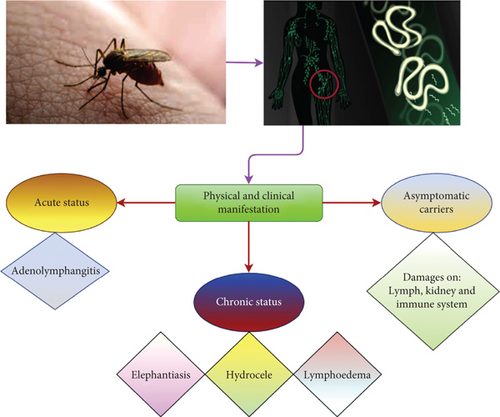
Lymphatic filariasis is a global health concern, exhibiting varying prevalence rates across different regions. It is transmitted by different mosquito vectors depending on the nematode species involved. The World Health Organization (WHO) in collaboration with governments recommended the implementation of mass drug administration (MDA) programs targeting both infected populations and those at risk [1]. Despite these efforts, the persistent prevalence of the disease emphasizes an urgent need for comprehensive research on its transmission dynamics to support eradication initiatives, aligning with Sustainable Development Goal 3 and the roadmap for eliminating neglected tropical diseases by 2030.
Mathematical modelling has been used to address lymphatic filariasis in different aspects. The key and fundamental studies include Mwamtobe et al. [7], who introduced a model on humans and mosquitoes and concluded that treatment is more effective than quarantine. Jambulingam et al. [8] worked on a statistical model with a hypothesis on MDA with respect to the burden in India, highlighting that the MDA duration is proportional to the endemicity baseline. Michael et al. [9] addressed the MDA efficacy and control with albendazole and diethylcarbamazine in combination. Swaminathan et al. [10] worked on challenges with the aspect of prospects targeting the elimination of the disease, and Cromwell et al. [11] developed a geospatial distribution between 2000 and 2018.
Regarding the convolution of the life cycle of the microfilarial parasites in both two hosts, modelling the interaction and spread mode is of significant importance when including stochasticity. Nevertheless, the existing models did not incorporate stochastic behavior in dynamics. The significance of the CTMC model is that it captures variabilities and uncertainties that arise due to environmental variations and demographics and also predicts the probabilities of extinction or outbreak in finite time and studies the random sample path solutions near disease-free and endemic equilibria [12–15]. This paper presents a stochastic CTMC model based on the modified existing deterministic models of lymphatic filariasis dynamics.
2. Model Formulation
2.1. A Deterministic Model
The formulation of the model that depicts the dynamics of lymphatic filariasis in both definitive-primary and intermediate hosts is based on assumptions that the vertical transmission is not accounted for by the exclusion of immigration considerations, adherence to the mass action principle for the rate of infection [17], and the occurrence of induced mortality in the class of infected chronic only. Figure 2 visually represents the dynamic modification of the work by Jambulingam et al. [8], Mwamtobe et al. [7], Stolk et al. [18], and Swaminathan et al. [10].
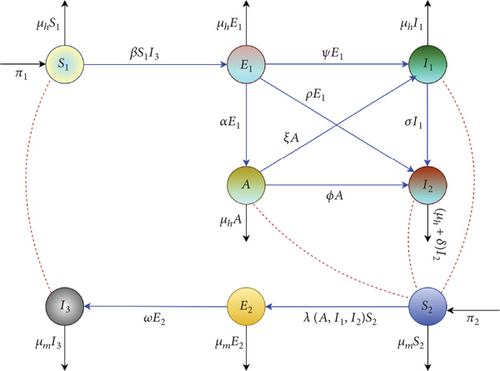
The human population is divided into five groups: susceptible S1(t), exposed E1(t), asymptomatic A(t), infected in the acute state I1(t), and infected in the chronic state I2(t). Similarly, the mosquito population comprises susceptible S2(t), exposed E2(t), and infected I3(t).
S1(t) recruited at a rate π1, move to E1(t) being bitten by I3(t) at a rate β. A considerable number of individuals progress to A(t) at a rate α, while the remaining proportion progress to either I1(t) at a rate ψ or I2 at a rate ρ. Moreover, A(t) progress to either I1(t) at a proportion of ξ or I2(t) at a rate ϕ. I1(t) progress to I2(t) at a rate σ. I2(t) induce death at a rate δ, and humans die naturally at a rate of μh.
Bounded by
S2(0) > 0, E10) ≥ 0, A(0) ≥ 0, I1(0) ≥ 0, I2(0) ≥ 0, S1(0) > 0, E2(0) ≥ 0, and I3(0) ≥ 0
2.2. Model Analysis
The dynamical system described by Equation (2) is subjected to evaluate its mathematical well-posedness and biological feasibility within the region .
2.2.1. Positivity
To demonstrate the positivity of model solutions for all t ≥ 0, let {t > 0 : S1 > 0, E1 > 0, A > 0, I1 > 0, I2 > 0, S2 > 0, E2 > 0, I3 > 0}, N1 = S1 + E1 + A + I1 + I2, and N2 = S2 + E2 + I3.
This contradicts the assumption, hence S1(t) > 0 for all t > 0. Applying a similar method as used to get Equation (3), then Model (2) is positive invariant ∀t > 0.
2.2.2. Boundedness
Consequently, Model (2) is bounded within the region .
2.3. Filariasis Free Equilibrium E0 and Basic Reproduction Number
2.3.1. Filariasis Free Equilibrium
2.3.2. Basic Reproduction Number
2.3.3. Global Stability of E0
Theorem 1. The filariasis-free equilibrium E0 is globally asymptotically stable when and unstable otherwise.
We decompose System (2) following the Metzler matrix technique as used in Stephano et al. and Castillo-Chavez and Song [17, 21]. Let u1 stands for (S1, S2), while u2 stands for (E1, A, I1, I2, E2, I3). Therefore, Model (2) can be decomposed to:
Matrix B1 has negative eigenvalues which determine that matrix B3 is a Metzler matrix. Given that the nondiagonal components of matrix B3 exhibit positivity, it is clear that E0 is globally asymptotically stable.
2.4. Filariasis Endemic Equilibrium E∗
2.4.1. The Global Stability Analysis of Endemic Equilibrium E∗
Theorem 2. Model System (2) exhibits a unique endemic equilibrium E∗ whenever , which is globally asymptotically stable.
Proof 1. We consider vector components and define a Lyapunov function G as follows:
By differentiating Equation (11) with respect to t, we have
Let , , c = A/A∗, , , , , and t = λ/λ∗.
Substituting equations in Equation (2) into Equation (12) gives the following expression of each term:
Summing up all expressions in Equation (13) and evaluating the values of ki, i = 1, 2, ⋯, 8 gives
Back substitution into Equation (13) and adding up gives
If an algebraic inequality 1 − z ≤ − lnz, for any z > 0, then we express all terms in Equation (14) as follows:
Considering the third term, we have:
A similar approach is applied to all terms. It is evident that dG/dt ≤ 0. Moreover, applying the Krasovkii–Lasalle theorem in Equation (14), dG/dt = 0, if and only if Y = E∗. Hence, the set consists of the singleton E∗. This concludes the proof.
2.5. Model Sensitivity Analysis
In this subsection, we utilize Latin hypercube sampling-partial rank correlation coefficient (LHS-PRCC) as a tool for sensitivity and uncertainty. The LHS-PRCC algorithm is robust and particularly suitable for nonlinear systems with a consistent relationship between input and output [17]. The algorithm integrates both uniform and normal probability density functions. This method is recognized for its effectiveness in managing nonlinear ordinary differential equations [22]. Moreover, it quantifies the level of the linear relationship between inputs and outputs to furnish PRCC indices, following the methodology described by [23]. The variable I3(t) in Model (2) is used as a showcase to demonstrate the change of PRCC indices with time.
The findings from the LHS-PRCC analysis offered valuable insights into the impact of all parameters against the chosen variable and associated uncertainties on System (2). In the context of statistical inference, PRCC indices close to or equal to zero have no significance. Figure 3(a) visually represents the PRCC indices, highlighting that π2, β, and β2 on outputs have strong directly proportion relationship. Conversely, parameters like μh and μm demonstrating the relationship in inverse proportionally with the model outputs. Figure 3(b) provides a comprehensive view of their sensitivity and illustrates how changes in all parameters influence Model (2). These findings suggest the important variables to be considered for effective control strategies.
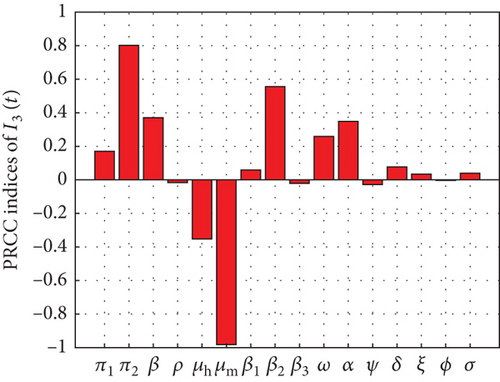
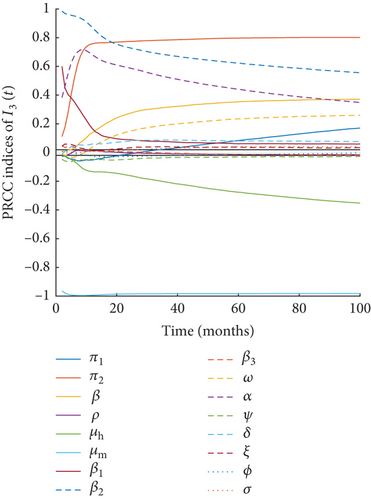
2.6. CTMC Stochastic Model Formulation
To assess probabilities of extinction or persistence, the CTMC model was formulated using the technique of events from the process of multitype branching. Capturing the real-world phenomena in the dynamics of lymphatic filariasis, incorporating randomness, is necessary for uncertainties and variabilities [24, 25]. The disease can vanish even when the threshold exceeds one, depending on the initial number of infections available in the population. This study considers individual movement to be discrete for realistic depiction [13, 14].
The formulation of the CTMC stochastic model is derived from System (2) events.
We define S1(0) = π1/μh and S2(0) = π2/μm, where infectives of type i, denoted as Ii, give rise to infectives of type j, denoted as Ij. It is assumed that the number of offspring produced by an individual of type i is independent of the number of offspring produced by either type i or type j, where j ≠ i [14, 26].
Filariasis extinction is defined by probability , where (r1, r2, ⋯, rk) is the unique fixed point of the offspring pgf, pi(r1, r2, ⋯, r6) = ri, and 0 < ri < 1 for i = 1, 2, ⋯, k, whereas 1 − ℙ0 is an outbreak probability.
The probability-generating functions r1, r2, ⋯, r6 exhibit nonlinearity, rendering them difficult to compute analytically. Consequently, numerical simulations, as demonstrated by Stephano et al. [15], are employed for their computation.
3. Model Simulations
| Parameter | Baseline | Reference | Range | Normal (mean (μ), std (σ)) |
|---|---|---|---|---|
| π1 | 20.0000 | [16] | [10.000030.0000] |
|
| β | 0.0005 | [17] | [0.000100.0050] |
|
| β1 | 0.0015 | [17] | [0.00100.0030] |
|
| β2 | 0.0035 | [17] | [0.00150.0045] |
|
| β3 | 0.00025 | [17] | [0.000150.00035] |
|
| ρ | 0.00032 | [17] | [0.000250.0075] |
|
| ψ | 0.0015 | [30] | [0.00250.0085] |
|
| δ | 0.000015 | [9] | [0.000010.00003] |
|
| ω | 0.0055 | [17] | [0.00350.0065] |
|
| ϕ | 0.00045 | [17] | [0.00030.0009] |
|
| π2 | 100,000 | [16] | [50000150000] |
|
| μh | 0.0142 | [15, 17] | [0.01000.0200] |
|
| α | 0.0200 | [9] | [0.01000.0500] |
|
| μm | 0.050000 | [30] | [0.01001.5000] |
|
| ξ | 0.00030 | [16, 18] | [0.00250.0055] |
|
| σ | 0.0012 | [10] | [0.00100.0030] |
|
Figure 4, depicting the solutions of the deterministic model, corresponds to Figures 5 and 6, showing both deterministic and CTMC stochastic solutions. It is evident that the count of susceptible individuals decreases following infections, stabilizing after approximately 100 months. Similarly, the population of susceptible mosquitoes diminishes, reaching a steady state. The results reveal that both deterministic and CTMC stochastic models exhibit similar behavior, with stochastic outputs reflecting randomness and deterministic outputs representing the average trend observed across CTMC random sample paths. A negative correlation exists between the susceptible groups and the acutely infected, chronically infected, and asymptomatic classes. Initially, the count of exposed humans rises, peaking within the first 60 months, before declining and eventually stabilizing after 150 months. Similarly, the numbers of asymptomatic, acutely infected, and chronically infected humans also peak before stabilizing.
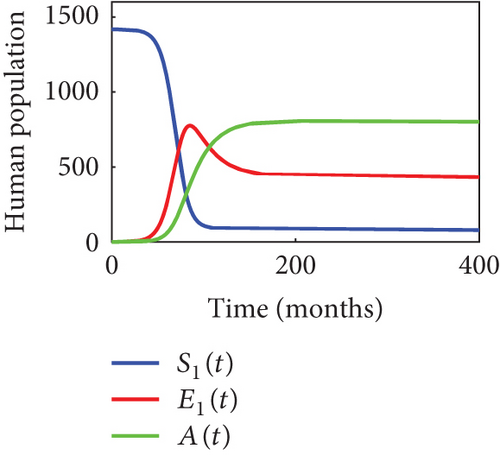
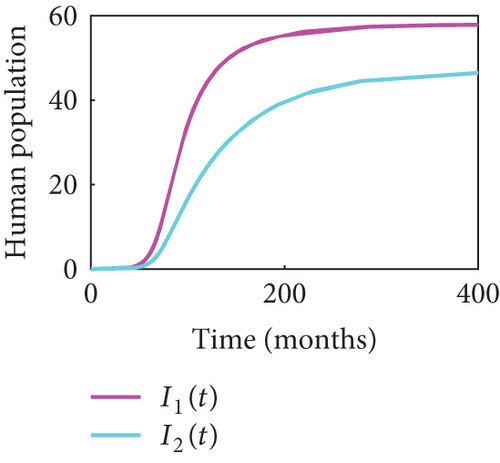
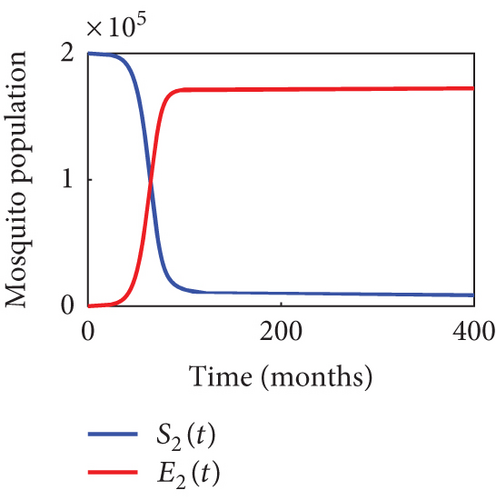
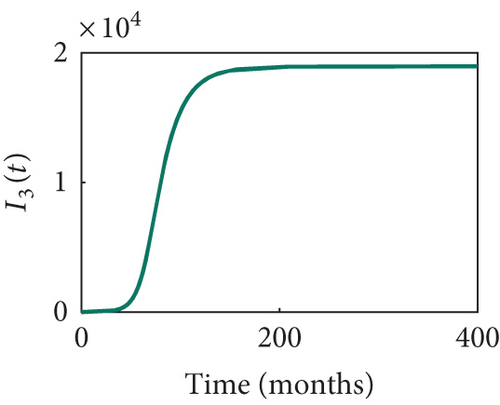
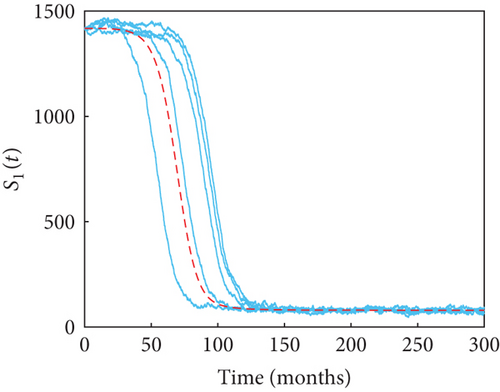
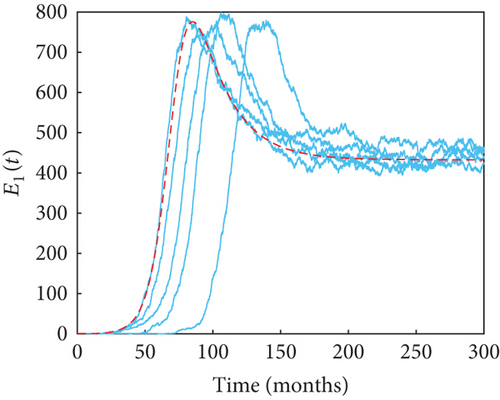
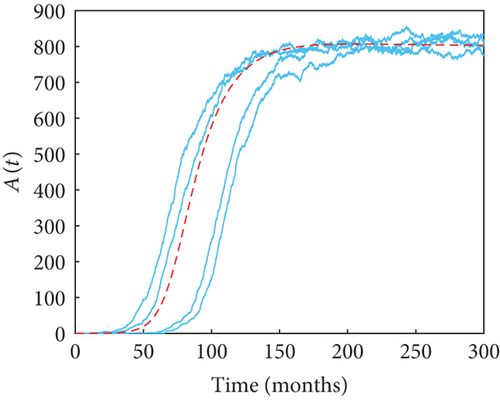
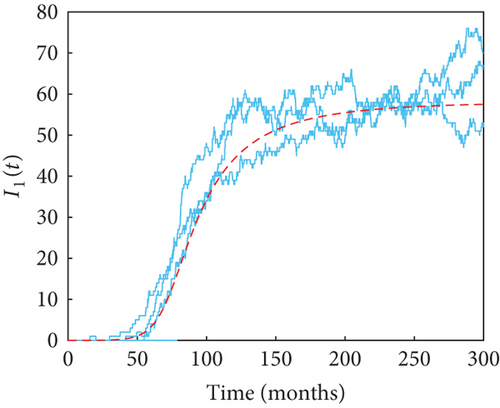
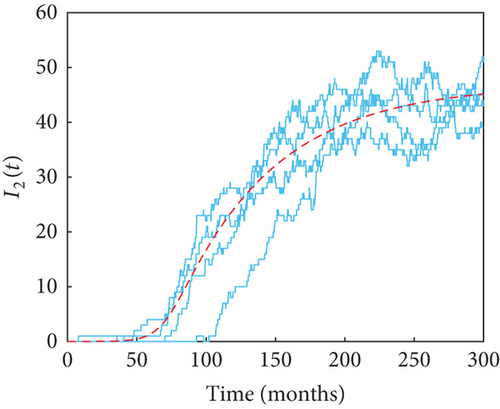
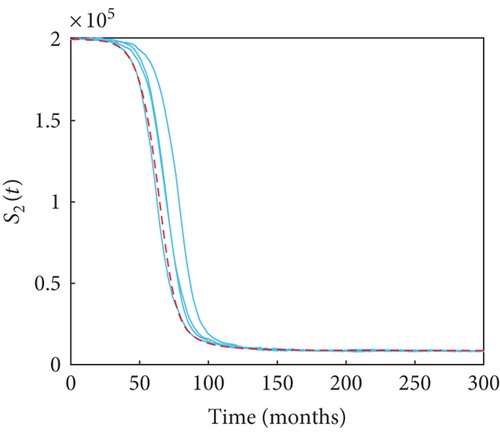
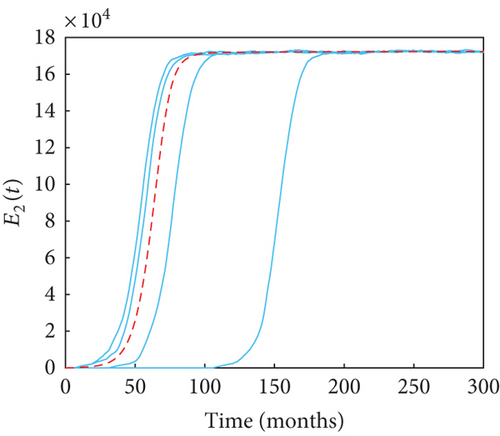
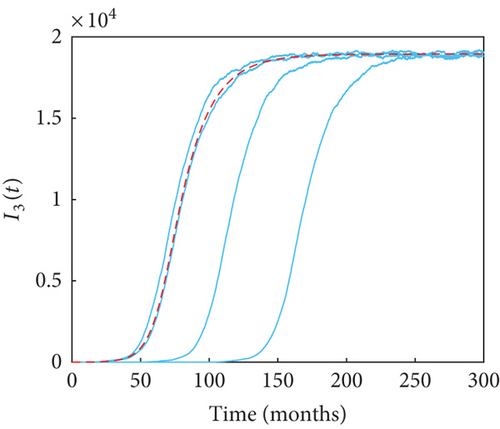
4. Conclusion
Based on the findings presented in this paper, it is evident that lymphatic filariasis poses a significant threat to human health, causing chronic and irreversible damage to the immune system. Through the development of both deterministic and CTMC stochastic models, this study is aimed at capturing the complexity of lymphatic filariasis dynamics. The deterministic model highlights the potential for disease extinction when the secondary threshold infection number falls below one, contrasting with scenarios where persistence is more likely to occur. Additionally, the role of asymptomatic carriers in disease transmission was identified as significant. These results emphasize the importance of employing stochastic models, such as CTMC, to capture variabilities, randomness, and associated probabilities more accurately, especially considering the limitations of deterministic models in capturing inherent complexities and unpredictabilities.
Conflicts of Interest
The authors declare no conflicts of interest.
Funding
The authors received no specific funding for this work.
Open Research
Data Availability Statement
All data is included in the manuscript.




